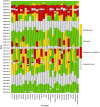Policies on children and schools during the SARS-CoV-2 pandemic in Western Europe
- PMID: 37564427
- PMCID: PMC10411527
- DOI: 10.3389/fpubh.2023.1175444
Policies on children and schools during the SARS-CoV-2 pandemic in Western Europe
Abstract
During the pandemic caused by severe acute respiratory syndrome coronavirus 2 (SARS-CoV-2), mitigation policies for children have been a topic of considerable uncertainty and debate. Although some children have co-morbidities which increase their risk for severe coronavirus disease (COVID-19), and complications such as multisystem inflammatory syndrome and long COVID, most children only get mild COVID-19. On the other hand, consistent evidence shows that mass mitigation measures had enormous adverse impacts on children. A central question can thus be posed: What amount of mitigation should children bear, in response to a disease that is disproportionally affecting older people? In this review, we analyze the distinct child versus adult epidemiology, policies, mitigation trade-offs and outcomes in children in Western Europe. The highly heterogenous European policies applied to children compared to adults did not lead to significant measurable differences in outcomes. Remarkably, the relative epidemiological importance of transmission from school-age children to other age groups remains uncertain, with current evidence suggesting that schools often follow, rather than lead, community transmission. Important learning points for future pandemics are summarized.
Keywords: COVID-19; children; masks; mitigation; school closure; testing; vaccination; ventilation.
Copyright © 2023 Soriano-Arandes, Brett, Buonsenso, Emilsson, de la Fuente Garcia, Gkentzi, Helve, Kepp, Mossberg, Muka, Munro, Papan, Perramon-Malavez, Schaltz-Buchholzer, Smeesters and Zimmermann.
Conflict of interest statement
The authors declare that the research was conducted in the absence of any commercial or financial relationships that could be construed as a potential conflict of interest.
Figures



Similar articles
-
Weighing policymaking: A narrative review of school closures as COVID-19 pandemic-mitigation strategies.Pediatr Pulmonol. 2022 Sep;57(9):1982-1989. doi: 10.1002/ppul.25787. Epub 2021 Dec 20. Pediatr Pulmonol. 2022. PMID: 34894111 Review.
-
COVID-19 and children.Science. 2022 Sep 9;377(6611):1144-1149. doi: 10.1126/science.ade1675. Epub 2022 Sep 8. Science. 2022. PMID: 36074833 Free PMC article.
-
Considerations for the Safe Operation of Schools During the Coronavirus Pandemic.Front Public Health. 2021 Dec 16;9:751451. doi: 10.3389/fpubh.2021.751451. eCollection 2021. Front Public Health. 2021. PMID: 34976917 Free PMC article. Review.
-
SARS-CoV-2 infection in children and implications for vaccination.Pediatr Res. 2023 Apr;93(5):1177-1187. doi: 10.1038/s41390-022-02254-x. Epub 2022 Aug 15. Pediatr Res. 2023. PMID: 35970935 Free PMC article. Review.
-
Human and novel coronavirus infections in children: a review.Paediatr Int Child Health. 2021 Feb;41(1):36-55. doi: 10.1080/20469047.2020.1781356. Epub 2020 Jun 25. Paediatr Int Child Health. 2021. PMID: 32584199 Review.
Cited by
-
Embracing dynamic public health policy impacts in infectious diseases responses: leveraging implementation science to improve practice.Front Public Health. 2023 Aug 17;11:1207679. doi: 10.3389/fpubh.2023.1207679. eCollection 2023. Front Public Health. 2023. PMID: 37663826 Free PMC article. Review.
-
COVID-19 RT-qPCR-based screening in Austrian schools and incidences in the general population: a Bayesian spatiotemporal analysis.Arch Public Health. 2025 Jun 13;83(1):152. doi: 10.1186/s13690-025-01655-8. Arch Public Health. 2025. PMID: 40514747 Free PMC article.
-
Long-term surveillance of SARS-CoV-2 in the school community from Campo Grande, Brazil.BMC Public Health. 2024 Jul 31;24(1):2057. doi: 10.1186/s12889-024-19555-x. BMC Public Health. 2024. PMID: 39085807 Free PMC article.
-
Effects of COVID-19-targeted non-pharmaceutical interventions on pediatric hospital admissions in North Italian hospitals, 2017 to 2022: a quasi-experimental study interrupted time-series analysis.Front Public Health. 2024 Apr 18;12:1393677. doi: 10.3389/fpubh.2024.1393677. eCollection 2024. Front Public Health. 2024. PMID: 38699417 Free PMC article.
-
Updated Surveillance Metrics and History of the COVID-19 Pandemic (2020-2023) in Europe: Longitudinal Trend Analysis.JMIR Public Health Surveill. 2024 Jun 21;10:e53551. doi: 10.2196/53551. JMIR Public Health Surveill. 2024. PMID: 38568186 Free PMC article.
References
Publication types
MeSH terms
Supplementary concepts
LinkOut - more resources
Full Text Sources
Medical
Miscellaneous

